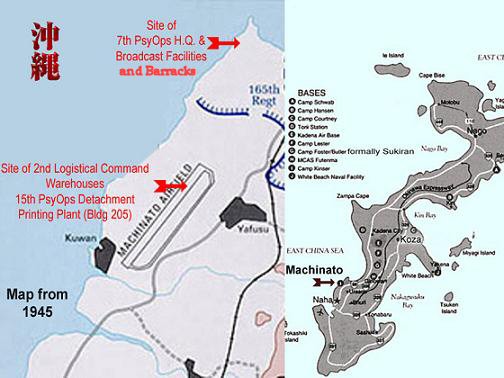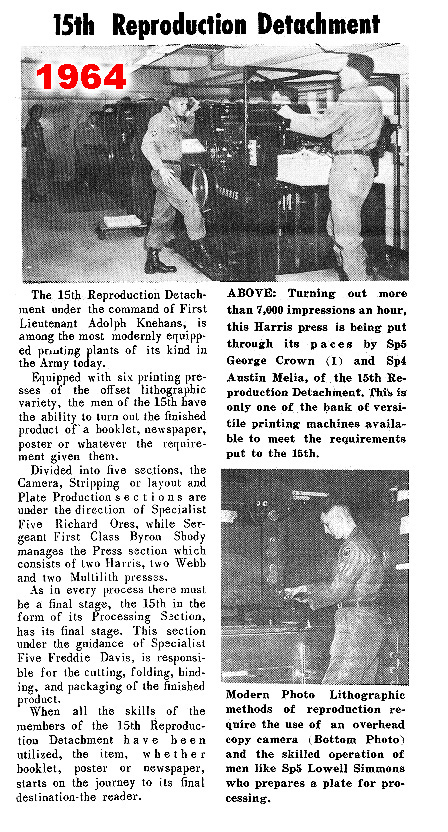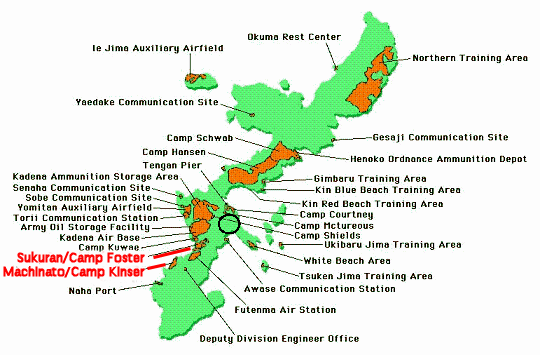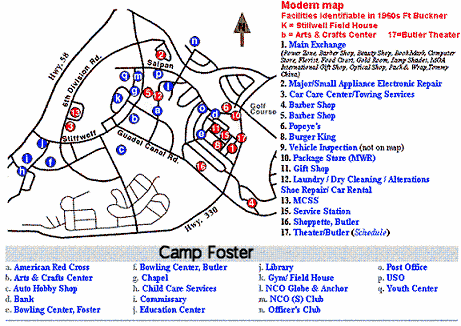Dennis kaliser 1966-67 Photo Album and Commentary and 1987 Revisit
EDITOR'S NOTE: Dennis kaliser provided numerous photos of his Okinawan tour with the 7th PsyOps Group. His photos of a visit to Okinawa in 1987 are also included. Photos are catagorized by location and date.
I have included commentary and comments about some changes that have occurred from my tour (1961-63) to Dennis's tour three years later. One change was a reorganizational name change as the 14th PsyWar Batallion became the 7th PsyOps group and the 14th PsyOps Batallion in 1965. All detachments including VUNC were renamed the 7th Group. The role of the 14th PsyOps Battalion is however unclear. (See Reorganization of 14th PsyWar to 14th PsyOps and 7th Group on main menu)
Album Menu
7th Group (14th PsyOps) Barracks and Communication Compound
 |
Map Provided by Dennis Kaliser |
The barracks and communication compound were located in Machinato near the Machinato Service Area between Naha and Sukuran (Zukeran) or Fort Buckner. The present day area contains the Marine base Camp Kinser.
Dennis indicated that the hill behind the barracks (picture 2, 4) was known as Ryan's Ridge during the Battle of Okinawa. What happened there in April 1945 is dramatically described in Chapter IX of TheFall of The First Shuri Defense Ring. http://www.ibiblio.org/hyperwar/USA/USA-P-Okinawa/USA-P-Okinawa-9.html
The barracks at Machinato Okinawa were used by the 14th PsyWar Battalion from approximately 1960 until 1966/67 when the 7th Group (reorganized) moved to barracks in Sukuran or Fort Buckner (Now Camp Foster). . This move was made necessary as the 2nd Logistical Command took over the Machinato area with the exception of the 7th communication compound.
One noted change to Machinato barracks was the addtion of another barracks at the south end after 1963. This barracks may have been occupied by 1st Special Forces (Picture 3).
Two of the pictures (5,7) which follow show Dennis Kaliser and myself (Tim Yoho) standing on roof of the Machinato barracks. Five years separate the two shots. Mine taken in 1961 does not show communication towers, extensive buildings and cannibalization area seen in Kaliser's 1966 picture. The communication compound in 1961-63 was very small and consisted of only a few buildings and communication huts. Picture 9 (poor quality B&W) shows one of the main buildings in the small compound in 1961. This may be the "relatively small area surrounded by a fence" described by Dennis below.
The cannibalization area shown in Kalizer's picture (5) includes many well used and war damaged vehicles from Vietnam.
Picture 5 with Dennis on barracks roof shows communication compound (and pic 6) labeled as the "Green Compound". The name was not used during my tour. Dennis explained why the area was named the "Green Compound":
It wasn't always called that. The area containing the broadcast facilities, 7th PsyOps H.Q. and other stuff I knew not of, was called "The Compound" as it was a relatively small area surrounded by a fence. The buildings were generally green or green and a second color. In early 1967 (not sure exactly when) John Wayne came to Okinawa and filmed the movie "The Green Berets". The movie was a big hit with military personal, though no one took it to be anything more than a laughable totally unrealistic typical John Wayne movie. The theme song also became a big hit. Some of the guys in the 14th made a parody on the song and sung about "The Green Compound" in lieu of the Green Beret. And so we thereafter referred to the place as "The Green compound".
I asked Dennis if he knew of the fate of the Deragawa compound where I spent over a year as a member of the 16th PsyWar Company. He indicated that the name was only vagely familiar and that he did not know if the site was still in existence during his time. He did indicate that the 16th Company was the only part of the 7th Group that went Airborne as a detachment. Dennis was a member of the 15th Detachment (printing).
With the exception of four pictures, all were taken by Dennis Kaliser and are dated 1966/67
| 1. | |
| 2. | |
| 3. | |
| 4. | |
| 5. | |
| 6. | |
| 7. | |
| 8. | |
| 9. | |
| 10 | |
| 11. | |
| 12. | |
| 13. | |
| 14. | |
| 15. |
15th PsyOps Printing Detachment
The Printing Detachment of the 7th PsyOps was located in Warehouse 205 on what used to be the WWII Japanese Machinato Airfield. (See Map Above)
EDITORS NOTE: I don't remember much about the printing detachment since I was in the 16th or Communication Detachment during my tour from 1961-63. I do not remember any facilities used on the old Machinato Airfield above the barracks. I vaguely remember that the printing presses were located somewhere in Naha but need someone from this time period to verify.
 |
Dennis Kaliser was a member of the 15th Printing Detachment and conveyed the following about his background and role in the 15th:
 |
After basic training in Ft. Jackson, I got my MOS training at the Engineer school in Ft Belvoir Va. From there I was assigned to the unit in Okinawa. I was transported to Okinawa aboard the troop ship USS Patrick. I think I was the only guy in the printing branch who actually wanted a career in the printing industry. After the Army, I enrolled at the Rochester Institute of Technology and graduated with a BSc in Printing Management.
|
I and others like me in the printing branch (15th) were printing propaganda leaflets in Vietnamese and some in Korean. As no one in the unit spoke either language, we could only guess at what the leaflets said. It was only after a particular leaflet campaign was over that we saw an article in the Stars and Stripes describing the results of the campaign. I saved some of the leaflets as well as one of those articles.
There was a "Choi Hoi" campaign whereby a surrendering VC supposedly would not be shot if he held the leaflet up while surrendering. It also showed how well they would be treated in a POW camp. there there was the scare type of leaflets usually with the title "Born North, Die South" showing badly mangled, partly decomposed NVA.
Most of the leaflets were in Vietnamese, but some were in Korean. These were the "Jilli" leaflets to be dropped over North Korea. This was an ongoing campaign left over from the Korean War. On one ocassion, the guy who positioned the film for platemaking got the film backwards and a million or so Jilli leaflets were printed backwards. No one knew the difference until the batch reached Korea.
Just to have some idea what the other side was doing "PsyWar wise", I had a short wave radio and listened to English broadcasts from Radio Peking from time to time. 1966 was the beginning of the "Great Proletarian Cultural Revolution" when China went totally bananas. The broadcasts were so bizarre that we laughed at them and couldn't believe how anyone could swallow that stuff. But then, we knew millions did, and we were embroiled in a real "PsyWar".
The following pictures and materials were all provided by Dennis. Most are from his Power Point Presentation of the 15th. Unfortunately, there is a glitch in the program and only the slides are presented below.
Veritas Officers and Staff in 1966 "Veritas" was a publication by the 7th Group & 14th PsyOps |
"Okinawa Key Role in Vietnam" 1966 Philadelphia Inquirer Article |
"Leaflet Blizzard Contributes To Final Victory in Vietnam" AP Article 1966 |
Slides From Power Point Presentation
Sukuran/Zukeran/Ft. Buckner/Camp Foster
 |
 |
Both of the above maps provided by Dennis Kaliser
There have been so many name changes over the years it is some times difficult to know where one was in the 1960's by looking at a modern map of Okinawa. Machinato (in red) in the first map is now called Camp Kinser and is occupied now by Marines. This was the main site of the 7th Group (14th PsyOps).. Deragawa (Some where in Black Circle) was site of the 16th Company until at least 1965. I am still trying to determine the fate of the Deragawa site after 65.
In the 1960's Sukuran (in red) was also known as Zukuran and Fort Buckner named after General Simon Buckner who was killed there during Battle of Okinawa. After the Marines took control of the area in the 1970's the area was known as Camp Zukuran and finally Camp Foster. With all due respects to the Marines, I don't know why the name Fort Bucker was dropped in favor of Camp Foster especially considering Buckner, a general was killed there. I guess the Marines just did not want any Army connections to a Marine base Camp..
The second map shows a more recent view of Camp Foster. The only locations shown on the map that were present in the 1960's when known as Fort Buckner were the Stilwell Field house, the Arts and Crafts Center and the Butler Theater. Various barracks present in the 60's may or may not be present today. One of the barracks housed the 7th PsyOps after the quarters in Machinato were taken over by the 2nd Logistical Command.
A few pictures provided by Dennis show the Arts and Crafts Center, the Butler Theater, Stillwell Field house and various barracks.
Around The Island in 1966/67 and Revisit in 1987
Dennis Kaliser related the following to me in an e-mail in July 2005:
In 1979 I came to work for an Israeli company called Scitex which pioneered the digital age in printing technology. I moved to Israel at that time where I still live today. It was with this company that I traveled the world and had a couple of business trips to Japan. On the first of these trips in 1987 I detoured for a nostalgic weekend in Okinawa.
I was very surprised to see how much the place and the people had changed in the last 20 years. As the Island returned to Japanese control in 1972, driving was on the left instead of the right, Naha was full of luxurious hotels and there were at least 8 Jumbo jets a day flying in and out of Naha loaded with Japanese tourists. Okinawa had become the " Florida " of Japan . There were modern highways with normal speed limits, not like the 30mph limit when I was stationed there.
Nostalgia wise, I was just a bit saddened to see that the Army presence on the Island was all but gone. Just about all the military bases had become marine bases. The Machinato service area where the printing branch was as well as the "Green Compound" where the broadcasting studio and transmitter used to be was now Camp Kinser a Marine Base.
The town of Makiminato along with civilian parts of Machinato eventually became part of sprawling Urasoe. I asked a taxi driver to see if we could find my old "hooch" in Makiminato, but the place had changed so radically that I could not be sure of the street where I lived and all the old tiny houses had been replaced by modern apartments.
The smelly benjo ditches were also long gone from Makiminato and Naha as well. I still remember back in '66 seeing one kid peeing in the bengo ditch and just a little ways down the hill seeing kids playing with their toy boats in the same ditch.
I asked the Taxi driver to take me to Zukeran, but he didn't recogonize the name. Ft Buckner aias Zukeran changed to Camp Butler/Foster and for some unknown reason to me, the Japanese name Zukeran disappeared. The base name change seems unfortunate to me as Army General Buckner was the commander of operations during the battle of Okinawa and was killed during the battle. I guess the tradition is too strong that a Marine base cannot be named after an Army General. I tried to go onto the base for a visit, but as a civilian, they wouldn't let me past the gate. Koza with its infamous "four corners" was gone and in its place was the fairly modern town of Okinawa city.
As I was alone and had no contacts with the American military, I took a Japanese bus tour or two of the island. I was the only westerner on the bus and the tour guide spoke no English. None the less, it was most enjoyable. I was able to follow most of what the tour guide said based on my recall of Okinawa history and the few words of Japanese I remembered. It was April and the weather was perfect. The island really is beautiful and getting to see it once again, this time as a pampered civilian staying in a fancy hotel gave me a very different perspective than as a young enlisted trooper back in '66.
Anyhow, lots more memories, but just wanted to share some of them when I saw your site.
Best regards
| Koza Street 1967 |
Map of Okinawa Showing Location of Makiminato in next four Pics Map also shows location of Koza. |
| Neighbors of my Hooch in 1967 |